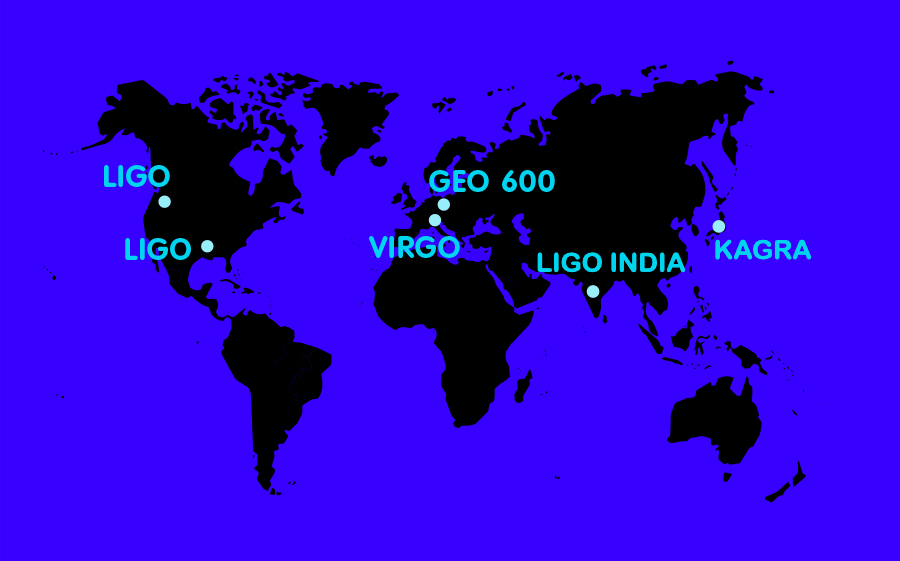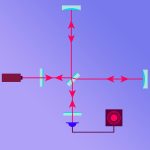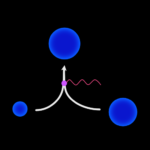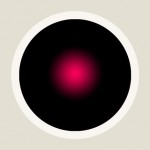Listening posts around the globe
Overview of the gravitational wave detectors currently operational, or under construction
An article by Badri Krishnan, Carsten Aulbert
Currently, scientists in listening posts all across the globe are busily detecting gravitational waves, upgrading the existing detectors and planning new ones.
Before we start describing the different projects, here is a map of their locations:

Interferometric detectors
The state of the art in search of gravitational waves are the interferometric detectors which have been under development since the 1980s and whose technology continues to be improved and refined. After long periods of planning and constructions, there are currently the following projects:
GEO600 has an arm-length of 600m and is located in Ruthe, Germany (near Hanover). It is operated by the Max Planck Institute for Gravitational Physics in Hanover. The GEO collaboration consists of 250 members and is part of the LIGO scientific collaboration.
LIGO is an abbreviation for “Laser Interferometer Gravitational Wave Observatory”. The LIGO project has two interferometric detectors in the United States, “Advanced LIGO”, each with arm lengths of 4 kilometres. They are located in Hanford, Washington, and Livingston, Louisiana. A third detector of the LIGO network has been under construction in India in 2020.
Virgo is a European detector with an arm-length of 3 kilometres near Pisa in Italy. The initial detector, Virgo, was upgraded to achieve 10 times higher sensitivity and started operation as Advanced Virgo in 2017.
KAGRA (Kamioka Gravitational Wave Detector) is an underground gravitational wave detector in the Kamioka mine in Japan. It uses cyrogenic technology, which means that the mirrors are cooled down to 20 Kelvin in order to reduce thermal noise. The detector has been in operation since 2020.
Planned projects
LISA (Laser Interferometer Space Antenna) is an ESA/NASA project for a space-based interferometric gravitational wave detector. LISA consists of three spacecraft in orbit around the Sun moving in the formation of a near-equilateral triangle whose sides are 2.5 million kilometres long. LISA is currently scheduled to launch in 2034.
Cosmic Explorer is a proposed third generation interferometric gravitational wave detector. It will be built in the United States and is designed with an L-shaped geometry, each arm being up to 40 kilometers in length to achieve greater sensitivity than ever before.
The Einstein Telescope is planned as an underground third generation gravitational wave detector in Europe with arm lengths of 10 kilometers. Underground installation, as for KAGRA, is supposed to reduce the influence of Newtonian and seismic noise.
NEMO (Neutron Star Extreme Matter Observatory) is an Australian project that has so far proposed a design for a gravitational wave interferometer optimized to specifically study neutron star mergers.
Resonant detectors
The first type of gravitational wave detectors were resonant mass antennas. The center piece of such a detector is a solid metal object. Passing gravitational waves make that central test-mass oscillate, and these oscillations can be measured and amplified to detect the gravitational waves. Such antennas were set up in Rome (NAUTILUS) and Padova (AURIGA), Italy, in Geneva (EXPLORER) , Switzerland, in the US (ALLEGRO), and in Perth (NIOBE), Australia, forming the International Gravitational Event Collaboration. Yet, the sensitivity of these early instruments did not seem to allow efficient detection of gravitational waves. However, third generation resonant mass antennas, which use spherical test masses, are still in operation at Leiden (MiniGRAIL), The Netherlands, and Sao Paulo, Brazil (Mario Schenberg).
Further Information
For background information on gravitational waves, check out Elementary Einstein, particularly the chapter Gravitational waves. Related Spotlight topics on Einstein-Online can be found in the section Gravitational waves. This article from 2010 was updated in November 2020 with contributions from Harald Lück, Albert Einstein Institute/ Leibniz University Hanover.
Watch a short video about GEO600 on YouTube (German, with English subtitles).
Colophon
is a physicist and professor at the Institute for Mathematics, Astrophysics and Particle Physics at Radboud University, The Netherlands.
is a scientist at the Albert Einstein Institute in Hanover.
Citation
Cite this article as:
Badri Krishnan, Carsten Aulbert, “Listening posts around the globe” in: Einstein Online Band 12 (2020), 12-1003








